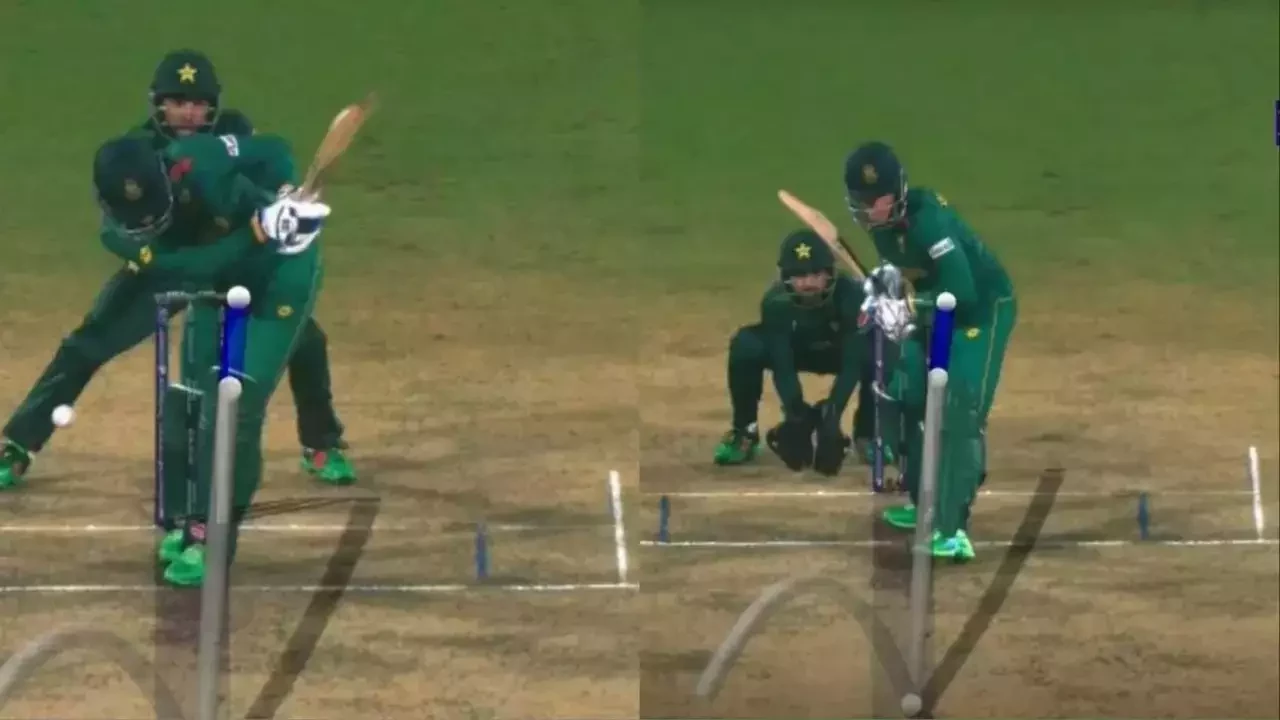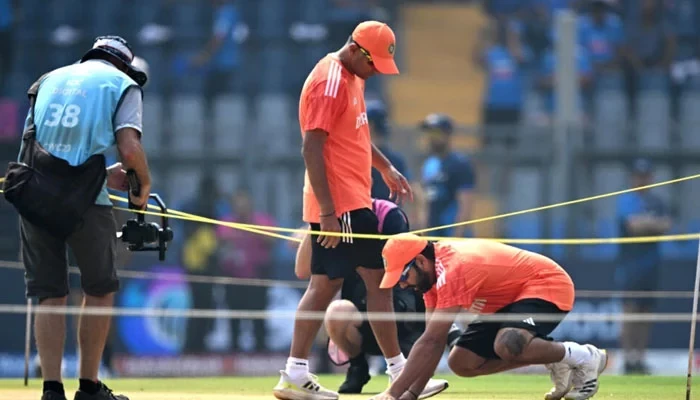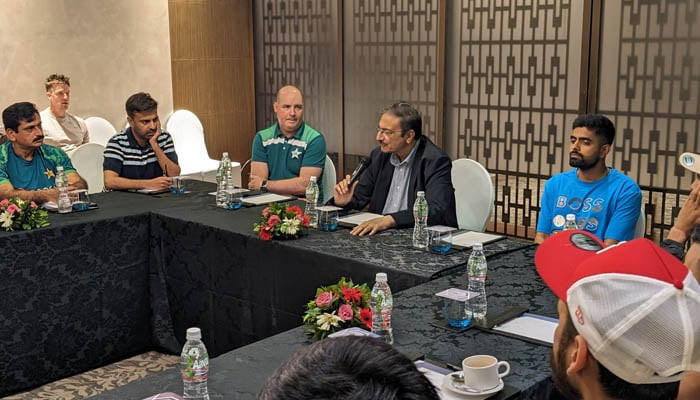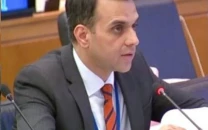A cup brimming with controversy
The Express Tribune recaps the thrills, contentions & unforgettable moments that marked world cricket’s pinnacle event

The International Cricket Council (ICC) Men's Cricket World Cup 2023 has etched its name in history, not just for the thrilling cricket matches on display but also for becoming the most attended ICC event ever. With an astounding 1,250,307 fans filling the stadiums in India, the tournament has showcased the unwavering passion and enthusiasm of cricket enthusiasts from around the globe. From the momentous opening clash between England and New Zealand to the highly anticipated India-Pakistan encounter, the tournament has been a spectacle, drawing unprecedented crowds.
However, amidst the record-breaking attendance and the on-field heroics, a different narrative has emerged, sparking debates about whether the tournament seemed more like a Board of Control for Cricket in India (BCCI)-led event than an ICC spectacle. The controversies, decisions, and statements made by the ICC during the course of the tournament have fuelled discussions about the influence of the Indian cricket board on the global cricketing stage.

Timed out
In a dramatic turn of events during Sri Lanka's World Cup group match against Bangladesh in Delhi, Angelo Mathews made history by becoming the first player ever to be timed out in international cricket due to a helmet malfunction. The incident unfolded as Mathews, in his final preparations before facing Shakib Al Hasan, experienced a broken helmet strap just as he was tightening it around his chin.
Requesting a replacement helmet from teammate Chamika Karunaratne, Mathews faced a race against time to be ready to face his first ball within the two minutes allowed by the ICC playing conditions. However, his delay led to an appeal initiated by Bangladesh's fielding captain, Shakib Al Hasan, for a timed out dismissal.
Despite Mathews' efforts to resolve the helmet issue and discussions with umpires Marais Erasmus and Richard Illingworth, the decision to rule him timed out was upheld. The reserve umpire, Adrian Holdstock, explained during the innings break that no discretion is given for equipment malfunctions, emphasising the need for batters to be ready to receive the ball within two minutes.
Video footage revealed that between a minute and 50 seconds and a minute and 55 seconds had passed since the dismissal of the previous batter, Sadeera Samarawickrama. The ICC playing conditions state that the incoming batter must be ready within two minutes, and Mathews failed to meet this requirement.
Mathews, visibly frustrated, kicked his helmet and threw his bat in annoyance as he left the field. His dismissal left Sri Lanka in a challenging position at 135 for 5. However, Charith Asalanka's century helped the team recover, finishing at 279.
While some, like Haroon, believe that the rule should be followed, they suggest that the first call should come from the umpire. They argue that the umpire, aware of the two-minute requirement, should consult with the captain before making the decision to avoid placing the responsibility solely on the captain.

DRS
In the match between Pakistan and South Africa, the Decision Review System (DRS) sparked controversy, leading the ICC to issue a clarification. The incident involved Proteas batter Rassie van der Dussen's lbw decision, where an erroneous display of graphics initially showed impact as "umpire's call" and the wicket as "missing." The ICC clarified that the incomplete graphic was a mistake, and the correct details were later displayed.
In the same match, another contentious decision occurred in the 46th over. Haris Rauf's delivery to Tabraiz Shamsi, initially given not out by the on-field umpire, was referred to DRS by Pakistan. Despite the ball pitching outside off and grazing the leg stump, the impact was in line with the stumps. The on-field decision was upheld, allowing Shamsi to survive, contributing to South Africa's fifth win.
In a separate match between South Africa and India, former Pakistan cricketer Hasan Raza raised concerns about India manipulating DRS. Raza pointed to an instance where Ravindra Jadeja dismissed Rassie van Der Dussen, suggesting that the DRS decision was suspicious. Despite the on-field umpire's initial decision, DRS revealed the ball hitting the middle and leg-stump, leading to van der Dussen's dismissal.
Raza expressed scepticism about the DRS process, emphasising the need to investigate such occurrences. He also mentioned previous instances, including the South Africa vs. Pakistan match, where DRS decisions favoured India.
Former Pakistani batter Haroon Rashid, who played 23 Tests and 12 ODIs from 1977 to 1983 weighed in on the DRS controversy, advocating for dropping the rule of ‘umpire's call.’ “If the ball is hitting the wickets, it should be given out. We have seen in this tournament that the same situation in two different matches had different decisions. This should not be the criteria to decide the fate of the batsmen,” he said.

Wide ball
Controversy surrounded a non-wide call by umpire Richard Kettleborough in a match where Virat Kohli achieved several records and became the leading run-scorer in ICC white-ball events. Kohli was on 97 runs, and India needed just 2 runs to win in the 42nd over bowled by Bangladesh's Nasum Ahmed. The first ball down the leg-side wasn't signalled a wide, and Kohli subsequently hit a six to reach his century and seal the match.
Critics suggested that the non-wide call was made to favour Kohli's century, accusing the umpire of bias. However, it's noted that the decision aligns with changes in the Laws of Cricket by the MCC in 2022. The amended law considers the batter's position and movement, not just the initial guard position, when judging a wide.
Before the change, the law focused on whether the ball would pass wide of the striker's standing position in a normal guard. The updated law acknowledges modern batting movements, ensuring fairness. Kohli's lateral movement in his stance likely influenced the umpire's decision, considering the amended criteria.
Speculation arose that Bangladesh intentionally tried to bowl a wide to prevent Kohli from reaching his century. However, Bangladesh captain Najmul Hossain Shanto denied these claims, asserting that there was no intentional wide bowling from their side.

Coin toss
Following the controversy over the pitch conditions, social media erupted with claims that the coin toss in the semi-final between India and New Zealand was 'fixed' to favour the Indian side. Allegations cantered on Indian captain Rohit Sharma's tossing technique, with netizens suggesting he deliberately threw the coin too far, preventing New Zealand skipper Kane Williamson from clearly seeing the outcome.
Video footage from multiple matches, including the semi-final, showed instances where Rohit Sharma tossed the coin away from the designated toss pad. In these cases, the opposing captain appeared not to verify the outcome independently and relied on the umpire's declaration. Out of the 11 tosses in the tournament, India won five, including three of the last four matches leading up to the semi-final against New Zealand. However, India lost the toss in the final against Australia. The repeated instances of coin toss controversies fuelled speculation and discussions on social media regarding fair play and the integrity of crucial match rituals.

Ball change
Former Pakistani cricketer Hassan Raza, following India's dominant performance against Sri Lanka, raised questions about the quality of balls provided to the Indian bowlers in the ongoing World Cup. When asked about the significant movement achieved by the Indian bowlers, Raza drew a comparison with the bowling styles of legendary South African duo Allan Donald and Makhaya Ntini.
Raza expressed a suspicion that the ball used by Indian bowlers might be changed mid-innings, affecting its behaviour. He suggested that whether it's the ICC, the umpires' panel, or the BCCI providing the balls, there should be an inspection. Raza speculated that the balls given to India could have an extra layer of polish, allowing them to generate more extravagant swing and seam compared to other teams.
“The ball used to be shiny on one side and rough on the other, allowing it reverse, seam, and swing. But here I feel like the ball is getting changed mid-innings the way it is behaving. Whether it is the ICC that is providing the balls, or the umpires panel, or the BCCI, there should be an inspection on it. I think the balls should be checked,” said Raza.

Pitch switch
Controversy arose ahead of the first semi-final between India and New Zealand at the Wankhede Stadium when reports surfaced suggesting a last-minute pitch change, allegedly aimed at giving an advantage to the Indian team in the crucial knockout match.
The ICC responded to the reports, clarifying that the decision to change the pitch was made in consultation with the independent pitch consultant, Andy Atkinson. The ICC stated that adjustments to planned pitch rotations are common towards the end of a lengthy event and emphasised that this change was recommended by the venue curator in collaboration with the host.
Haroon, the cricket expert, pointed out that pitches are typically allotted numbers before the event begins to ensure the best pitch for important matches. He noted that the ICC curator was informed in advance that pitch 7 wouldn't be available for the semi-final. “The controversy could be around why the pitch wasn't available despite being predetermined,” he said.
Addressing speculation that the pitch change was made to favour Indian spinners, Haroon argued that on the contrary, fast bowlers were more effective on the day. He dismissed the notion that the alteration aimed at spin-friendly conditions, emphasising the performance of the fast bowlers during the match.

Irfan Pathan’s celebration with Afghan team
Following Afghanistan's historic eight-wicket victory over Pakistan in their first-ever One Day International (ODI) win against the Men in Green, former Indian all-rounder Irfan Pathan, now working as a broadcaster, joined Afghan spinner Rashid Khan on the field to showcase dance moves in celebration.
However, the spontaneous dance gesture by Pathan received mixed reactions, particularly from Pakistani cricket fans. Some fans expressed displeasure and trolled the former Indian pacer, accusing him of displaying biased emotions in the aftermath of Pakistan's defeat. The incident highlights the intense emotions and rivalries often associated with cricket, where gestures and actions, even celebratory ones, can evoke strong reactions from fans across borders.

One-sided crowd
The behaviour of the Indian crowd, particularly in the final of the World Cup, has drawn criticism from cricket fans worldwide. With an estimated 130,000 people cheering for India, the crowd was perceived as one-sided, and there were concerns about a lack of sportsmanship.
Australian cricketer Pat Cummins acknowledged the expected one-sided nature of the crowd but emphasised the satisfaction of silencing a big crowd. “The crowd's obviously going to be very one-sided but, in sport there's nothing more satisfying than hearing a big crowd go silent,” said Cummins.
Cummins emphasised the need to embrace every aspect of a final, from the heightened noise levels to the increased attendance and interest, urging players to remain focused and not be overwhelmed by the situation.
As the match shifted in favour of the Australian team, creating a moment of victory, the once boisterous Indian crowd fell into a pin-drop silence. Additionally, during the closing ceremony, on-field umpires Richard Kettleborough and Richard Illingworth were booed by the crowd without apparent reason, adding to the list of incidents that have caused outrage.
In contrast to the criticism, Haroon, the former cricketer with a wealth of experience, offered a nuanced perspective. He pointed out that the composition of ODI crowds in today's era is predominantly youthful, and their primary goal is to enjoy and support their team.
"What do you expect from them? They are there to enjoy and watch their team win. If it is not winning, they won’t be celebrating the other team’s victory," he pointed out. "If you are referring to the crowd at county matches or similar events, there, most of the crowd is retired, and they are there to enjoy cricket, and that’s what they do. Here at the World Cup 2023, the Indian crowd was there to see their team win."

Modi ‘snubs’ Pat Cummins
The most recent controversy emerged during the prise distribution ceremony when Indian Prime Minister Narendra Modi appeared to 'snub' Australian captain Pat Cummins. In video footage, a visibly dejected Modi is seen handing over the World Cup trophy to Cummins and leaving the presentation stage without shaking hands.
The act left Cummins looking lost on stage, and after the presentation, Modi walked away to shake hands with the remaining Australian players, leaving Cummins standing alone on the podium. The perceived snub has sparked discussions and debates, with some expressing disappointment in the lack of a handshake, while others speculate on the potential reasons behind the act.

No handshakes with BCCI officials
Australia cricketers Adam Zampa and Marcus Stoinis found themselves in a controversy after apparently ignoring and refusing handshakes with BCCI officials following their victory in the ICC Cricket World Cup 2023. The incident unfolded during the presentation ceremony, further adding to the disappointment of Indian cricket fans after their team's defeat.
During the ceremony, Stoinis walked past BCCI president Roger Binny, secretary Jay Shah, and cricket legend Sachin Tendulkar, opting to accept his medal from ICC Chairman Greg Barclay. Although Stoinis greeted Tendulkar without shaking hands, the cricket icon appeared somewhat bemused by the behaviour.
Similarly, Zampa walked past Roger Binny and Jay Shah after David Warner ensured to shake hands with all the officials on stage. While Zampa did shake hands with Tendulkar, there was a perceived lack of warmth in the gesture.
Indian fans expressed their discontent, describing Stoinis and Zampa as 'disrespectful' and 'pathetic.' However, some individuals defended the Australian cricketers, suggesting that they might not have been aware of whom they were supposed to shake hands with, attributing the situation to an ‘awkward’ and ‘poorly-run’ presentation ceremony.

Mohammed Shami leaves ‘sajda’ midway
During India's successful World Cup 2023 match against Sri Lanka, Mohammed Shami's apparent hesitation in completing a "sajda" (prostration) caught the attention of many. The fast bowler, who is the only Muslim player in the Indian squad, was seen going down in what seemed like an attempt to prostrate in celebration of his five-wicket haul but stopped midway.
Shami has been in excellent form during the World Cup, amassing 14 wickets in just three matches since joining the squad. His pivotal five-wicket performance played a crucial role in India's resounding 302-run victory in the match at Mumbai's Wankhede Stadium.
Social media users were quick to observe and offered varying opinions, with some speculating that Shami might have refrained from the sajda due to an awareness of representing a country with a history of Islamophobia events.

Legal case against Rizwan for offering Namaz
Amidst the excitement of the ODI World Cup 2023, a controversy surfaced involving Pakistan's star opener, Mohammad Rizwan. Despite his commendable performance with the bat, Rizwan has recently garnered attention for reasons unrelated to cricket.
After dedicating a century to the 'brothers and sisters in Gaza,' a gesture that stirred both praise and criticism due to the Israel-Palestine conflict, Rizwan is now at the centre of another debate. During a match against the Netherlands in Hyderabad, Rizwan, after scoring a well-composed 68 runs, was captured offering prayers on the cricket field. The video of this moment quickly went viral, eliciting diverse reactions.
Adding to the controversy, a formal complaint against Rizwan has been filed by Vineet Jindal, a lawyer from the Supreme Court of India, with both the ICC and the BCCI. Jindal contends that Rizwan's act of offering prayers during the match "raises questions about the spirit of the game."
It's worth noting that Jindal previously filed a complaint against Pakistan sports presenter Zainab Abbas over what he deemed "anti-Hindu" tweets, a controversy that led to her abrupt departure from the tournament.

Pakistani presenter sent back home
Zainab clarified that she was neither asked to leave nor deported, but the overwhelming online reaction to her presence in India led to her decision. While not an immediate threat to her safety, the online backlash raised concerns among her family and friends on both sides of the border, leaving her intimidated and scared.
Zainab acknowledged the hurt caused by her old social media posts and emphasised that they did not reflect her current values or identity. She offered an apology to anyone offended by the posts and expressed gratitude to those who had been concerned and supportive.

Babar Azam Leaked Messages
Former Pakistan skipper and wicketkeeper-batsman Rashid Latif claimed that Babar, the current captain, was not receiving responses to his messages sent to Pakistan Cricket Board (PCB) Chairman Zaka Ashraf, COO Salman Naseer, and Director Usman Wahla. In response, Ashraf asked the interviewer during a live show to show the screenshot of the message from Babar where COO Salman was inquiring about this situation.
The on-air sharing of the message during the live show received criticism from former cricketers and the public, with concerns raised about the display of personal WhatsApp messages of the captain on national television.

PCB under pressure
Inzamam resigned from his position as Pakistan's chief selector amid concerns about a potential conflict of interest. Reports revealed that Inzamam is a director in a UK-based company, Yazoo International Ltd, along with individuals connected to player representation, including the agency managing Babar, Shaheen Shah Afridi, and Mohammad Rizwan. Inzamam's brother is the company secretary.
The appointment dates of the directors coincide with Inzamam's tenure as chief selector, raising questions about the propriety of a national selector having a stake in a company linked to a prominent player agent. Inzamam stepped down to allow the PCB to conduct a transparent inquiry into the conflict of interest allegations. He expressed willingness to resume his role if cleared of the charges.
Although PCB said that they will take the important decisions after the tournament, but the resignation of Inzamam was accepted just a day before Pakistan team’s seventh World Cup outing against Bangladesh.
According to Haroon Rashid, a former Chief Selector, the inquiry against Inzamam should have been conducted before his appointment. He blames the lack of research and background checks that the PCB does before appointing anyone to the PCB or the team management.
“They should have checked this before. They are capable of running these checks beforehand. Doing this midway is not only embarrassing for the person but also for the board," he said, adding that, in his experience, the PCB tends to make poor decisions under pressure. He cited examples such as the removal of Sarfraz Ahmed, Younis Khan, Shahid Afridi, and Muhammad Hafeez from captaincy roles in the past.
He continued to criticise Babar's decision to step down as captain after returning from the World Cup. “England played worse than the Pakistan team. Did they change their team?” he questioned, while highlighting that this instability has been ongoing since 1992.
“Our management comes under pressure, and then they make decisions like these,” he said, adding that the appointment of the new team management was also done without following the proper channels. “You advertise the position, interview the candidates who applied, check their previous experience related to the position and the certifications they have received. But here, they just saw the name and brought them on board,” he said.
While sharing Wahab Riaz’s early story, he said, “Just some time back, he was contacting everyone to secure a place for him in the team, and now he is the chief selector with no past experience. I am not against bringing the young lot into management. This is a good sign. But they should be brought in on merit; only this way can the team progress. Otherwise, we have seen how Misbah-ul-Haq failed in management and Muhammad Hafeez in captaincy.”
According to him, not only is the selection of the team management poor, but also the team that the new management has chosen. “We are going with an inexperienced bowling side, and the Australian conditions are not easy,” he said.






1724926799-0/Untitled-design-(7)1724926799-0-208x130.webp)












COMMENTS
Comments are moderated and generally will be posted if they are on-topic and not abusive.
For more information, please see our Comments FAQ